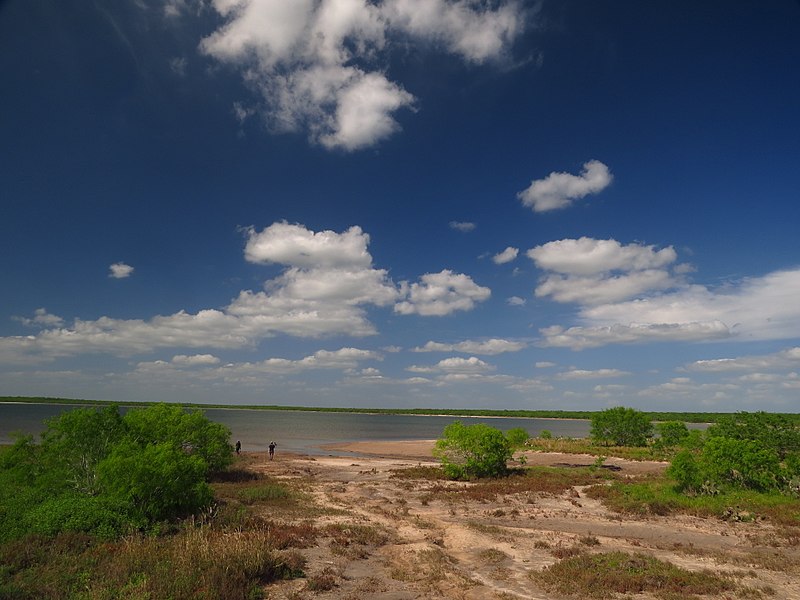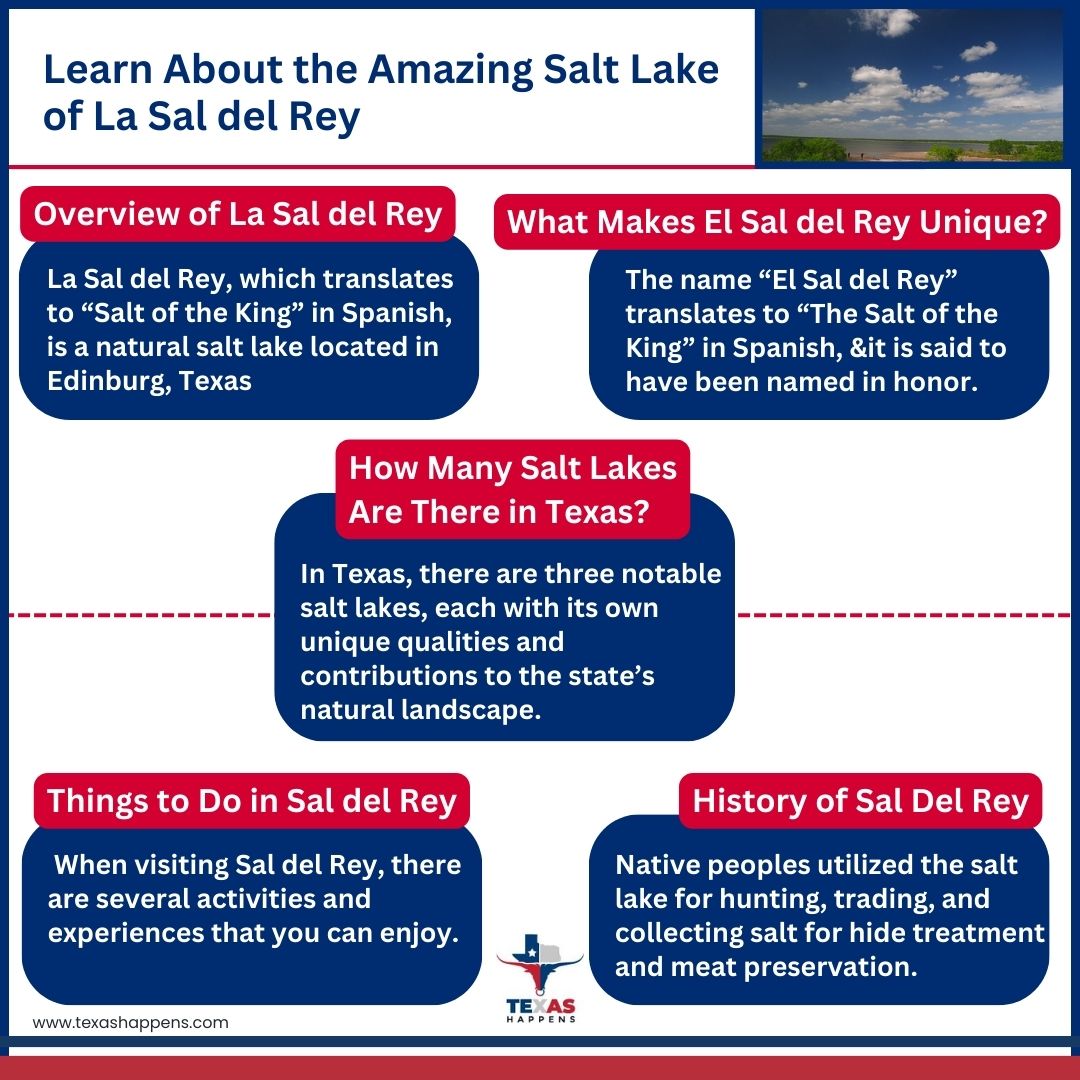La Sal del Rey stands out as one of the most extraordinary natural marvels in the state, resting on an astonishing four million tons of salt. It’s an experience like no other to literally walk on water at Salt Lake in Texas! Learn more about it as you read on.
Overview of La Sal del Rey
La Sal del Rey, which translates to “Salt of the King” in Spanish, is a natural salt lake located in Edinburg, Texas. It is situated in the northeastern part of Hidalgo County and part of the Lower Rio Grande Valley National Wildlife Refuge. El Sal del Rey is a unique geological and ecological feature that attracts visitors interested in its natural beauty and historical significance.
Among several salt lakes in the region, this hypersaline lake boasts an impressive four million tons of salt, making it over four times saltier than typical seawater. It covers over 1,200 acres, captivating visitors with its enchanting and otherworldly charm. Stretching as far as the eye can see, the glistening white salt crusts of La Sal del Rey provide a surreal and transcendental encounter.
The lake holds significant historical and cultural value, once serving as a crucial resource for indigenous communities and later becoming a prominent site for salt mining during the Spanish colonial era. During the war, both Spanish explorers and local residents extracted salt from the lake, as it was often the sole source of sodium in their diet. Today, it stands as a protected area, offering sanctuary to diverse bird species and granting nature enthusiasts the opportunity to witness the raw and serene beauty of this natural salt lake.
At low tide, you can observe the accumulation of salt deposits on objects within the water. When the salt concentration is high enough, you can practically walk on the water —an incredible experience! However, swimming is not advisable when the salt content is high. Yet, as the water level rises, some people enjoy soaking in the small pools.
To access the lake, a roughly 3-mile walk is required, with the parking area located on Brushline Road. Admission to the wildlife refuge is always free, and for more information about the Lower Rio Grande Valley National Wildlife Refuge, you can visit the U.S. Fish & Wildlife Service website.
To embark on the adventure of reaching Sal del Rey, be prepared for a hike. The dirt road leading to the lake is quite lengthy, so it’s advisable to bring ample water and snacks for sustenance and hydration along the way. Given the intense South Texas heat, taking precautions to prevent dehydration and heat exhaustion, such as wearing sunscreen and staying properly hydrated, is crucial. Restrooms are available along the route, providing an opportunity for breaks and refreshments if needed.
What Makes El Sal del Rey Unique?
The name “El Sal del Rey” translates to “The Salt of the King” in Spanish, and it is said to have been named in honor of a Spanish monarch. The exact origin of the name is uncertain, but it adds to the lake’s historical mystique.
The lake is approximately 600 acres in size and is surrounded by a barren landscape known as a “playa.” The playa is a flat, clay-rich surface that can sometimes hold water after rainfall. El Sal del Rey is fed by underground springs that bring salty water to the surface, which eventually evaporates, leaving behind large salt deposits.
The lake bed consists of rock-crystal salt, with an impressive sodium chloride composition of 99.0897 percent. The exact depth of the sizable salt deposit remains unknown, and its formation continues to be shrouded in mystery.
The salt deposits found in El Sal del Rey are composed mainly of sodium chloride, similar to table salt. These deposits have been utilized by humans for centuries. Native American tribes in the region, such as the Coahuiltecans and Karankawas, were known to extract salt from the lake for both consumption and trade. Later, during the Spanish colonial period, the lake’s salt was used by settlers and ranchers in the area.
Sal del Rey is renowned not only for its enchanting beauty but also for the purported therapeutic properties of its mineral-rich waters. The lake’s water is believed to possess healing effects, particularly in the treatment of arthritis. For centuries, people have sought solace in the healing waters of La Sal del Rey, finding relief from various ailments, including arthritis, joint pain, and skin conditions. The abundance of minerals, including sodium chloride, magnesium, and potassium, is said to promote relaxation and alleviate muscle tension, making it an ideal destination for those seeking natural remedies.
Beyond its therapeutic allure, La Sal del Rey offers a picturesque and distinct setting for visitors to explore the natural wonders of the Rio Grande Valley. The glistening crystalline waters and captivating rock formations create an idyllic backdrop for relaxation and rejuvenation.
Sal del Rey remains a hidden gem, unfamiliar to many visitors exploring the Rio Grande Valley. Its undiscovered charm beckons those seeking a unique and unforgettable experience.
History of Sal Del Rey
Native peoples utilized the salt lake for hunting, trading, and collecting salt for hide treatment and meat preservation. However, in the closing years of the 18th century, the Spanish explorers deemed the lake as part of the La Noria de San Salvador del Tule land grant issued by Spain to Capt. Juan José Ballí. Wooden carts were used in Spanish Texas to transport the salt into Mexico, and traces of the wagon tracks can still be found around the lake.
Explorers and settlers traded or sold salt to southern areas such as Nuevo Santander and Europe, with the Spanish king imposing taxes on this valuable commodity. Decades later, salt played a significant role in the U.S. Civil War.
Rock salt from La Sal del Rey served as the first export from the lower Rio Grande Valley. However, the amount of salt mined and exported from the lake declined during the Mexican War. In the Civil War, the demand for salt surged, leading the state government to assume control over its mining and export. Governor Francis R. Lubbock appointed Antonio Salinas of Brownsville as the controlling agent. Although Jesús Cárdenas, the owner of the lake, was allowed to sell the salt already mined, the Confederate government transported additional salt to designated points via camel caravans, with each camel carrying 600 pounds. However, freight thefts caused significant issues, leading to the abandonment of the camel project.
Apart from its value as a salt source, the lake has been used as a therapeutic wading pool for arthritis treatment and for decorating items such as branches. When branches are thrown into the lake, they can be retrieved a day or two later, adorned with sparkling crystals. In the early 1990s, La Sal del Rey was privately owned by Eloise Campbell.
According to the U.S. Fish & Wildlife Service, El Sal Del Rey was acquired in 1992 to be included in the Lower Rio Grande Valley National Wildlife Refuge. The land was purchased with the goal of preserving the primary geological feature, a 530-acre salt lake, along with its surrounding Tamaulipan thorn scrub and grasslands.
Things to Do in Sal del Rey
When visiting Sal del Rey, there are several activities and experiences that you can enjoy. Here are some things to do in Sal del Rey:
Take a walk or hike
Explore the surroundings of Sal del Rey by taking a leisurely walk or hike around the lake. You can immerse yourself in the natural beauty of the area, enjoy the serene atmosphere, and observe the unique features of the salt lake. The lake also boasts a sandy beach that rivals the pristine beauty of the salt crystals themselves. Combined with the secluded nature of this hidden gem, you may find it difficult to leave.
Birdwatching
Sal del Rey is a haven for birdwatchers. The lake and its surrounding habitat attract various bird species, including migratory birds and numerous rare bird species. Bring your binoculars and camera to spot and take photos of the diverse avian life in the area.
Photography
After immersing yourself in the saltwater to your heart’s content, make your way to one of the observation boardwalks to relish panoramic views of the surroundings. Capture the stunning landscape of Sal del Rey through photography. The glistening salt crusts, the contrasting colors, and the unique formations offer fantastic opportunities for landscape and nature photography. Of course, don’t forget to take snaps of yourself and your companions.
Natural therapy
As mentioned earlier, the lake has been known for its therapeutic properties. The lake sometimes acts as a therapeutic wading pool for arthritis, joint pain, and other skin conditions.
Relax and unwind
Find a peaceful spot along the lake’s shore and simply relax. Soak in the tranquility of the surroundings, listen to the sounds of nature, and take a moment to unwind in this serene environment.
Picnicking
Pack a picnic and enjoy a meal amidst the picturesque setting of Sal del Rey. Set up a blanket, savor your favorite food, and appreciate the beauty of nature while enjoying a delightful picnic experience.
How Many Salt Lakes Are There in Texas?
In Texas, there are three notable salt lakes, each with its own unique qualities and contributions to the state’s natural landscape. Let’s explore each of these salt lakes:
- La Sal Vieja: Located in Zapata County, La Sal Vieja is a saline lake known for its extensive salt flats and vibrant pink hue caused by high concentrations of salt and minerals. Situated within the Las Palomas Wildlife Management Area, it serves as a crucial habitat for various bird species. The lake’s striking colors and otherworldly appearance make it a fascinating sight for visitors.
- La Sal Blanca: Nestled in Hidalgo County, La Sal Blanca is a salt lake that showcases a mesmerizing white color due to its high salt content. It is situated near the southernmost tip of Texas, close to the Rio Grande River. Similar to La Sal del Rey, La Sal Blanca played a historic role as a source of salt for indigenous communities and later attracted Spanish explorers and settlers.
- La Sal del Rey: As previously mentioned, La Sal del Rey, meaning “The King’s Salt,” is a notable salt lake located in Hidalgo County. Spanning over 1,200 acres, it is known for its expansive salt flats and historical significance. The lake provided salt to indigenous communities and later became a significant site for salt mining during the Spanish colonial era. Today, it is a protected area that offers visitors the opportunity to witness the beauty of its vast salt crusts and observe various bird species.
These salt lakes in Texas contribute to the state’s diverse natural heritage, offering unique ecosystems and captivating landscapes. Each lake showcases the fascinating interplay of geology, climate, and history, making them remarkable destinations for nature enthusiasts, birdwatchers, and those seeking to explore the state’s distinct natural features.
Conclusion
El Sal del Rey is a fascinating natural salt lake in Texas, known for its historical importance and unique geological features. Whether you’re interested in its cultural significance or the diverse wildlife it supports, a visit to El Sal del Rey offers a glimpse into the natural beauty and rich history of the region.



